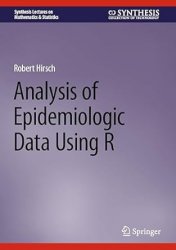 Название: Analysis of Epidemiologic Data Using R
Название: Analysis of Epidemiologic Data Using RАвтор: Robert Hirschs
Издательство: Springer
Год: 2024
Страниц: 115
Язык: английский
Формат: pdf (true), epub
Размер: 10.4 MB
This book addresses the description and analysis of occurrence data frequently encountered in epidemiological studies. With the occurrence of Covid-19, people have been exposed to the analysis and interpretation of epidemiological data. To be informed consumers of this information, people need to understand the nature and analysis of these data. Effort is made to emphasize concepts rather than mathematics. Subjects range from description of the frequencies of disease to the analysis of associations between the occurrence of disease and exposure. Those analyses begin with simple associations and work up to complex relationships that involve the control of extraneous characteristics. Analyses rely on the statistical software R, which is freeware in wide use by professional epidemiologists and other scientists.
R is free statistical software that is available for download on the web. It is usually run from an interface called “RStudio.” RStudio is set up with four quadrants. The lower left is where the programs are run. The lower right is where the documentation is available and where graphic output appears. The upper right is where datasets are listed, and the upper left is where you can see the content of datasets. Creation of datasets usually starts with the creation of vectors in the lower left quadrant. These vectors can be combined to create a dataset or data frame. A special kind of dataset is stored in a 2 × 2 matrix. These are often of use in epidemiology. We will be using several programs. These are arranged in packages. The “stats” package is the one we will use most often. Click on the name in the lower right quadrant to see a list of the programs available. Clicking on the name of the program invokes documentation on that program. Graphics are requested in the lower left quadrant, and they appear in the lower right quadrant. We use the “plot” command to create graphs. The plot command has several options used to customize your graph. The graphs can have additional data displayed using the “points” command. You can create a legend for your graph using the “legend” command. A special kind of graph used in epidemiology can be created using the “stepfun” function.
R is a collection of programs for statistical analysis and data management. It was first developed by two New Zealand statisticians, Ross Ihaka and Robert Gentleman and released in 1993. It has since been expanded and modified by the R Core Team and the R Foundation for Statistical Computing. Statistical packages for R have been developed by users and made available to the R community. These packages as well as the original collection of programs are available free of charge and are widely used by epidemiologists and other researchers. R has many collections of programs available. We will use several of these throughout this text. These collections of programs are called “packages.” We can see which packages have been installed in the lower right-hand quadrant under the “Packages” tab. There, you will see the names of several packages that are available. The ones that are installed will have a check in the box to the left of the name of the package.
Скачать Analysis of Epidemiologic Data Using R